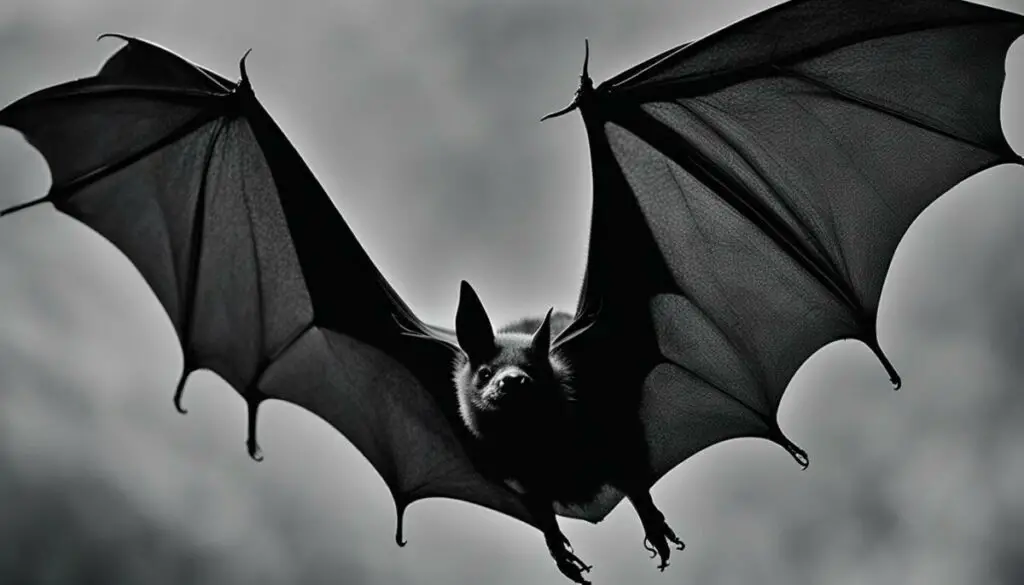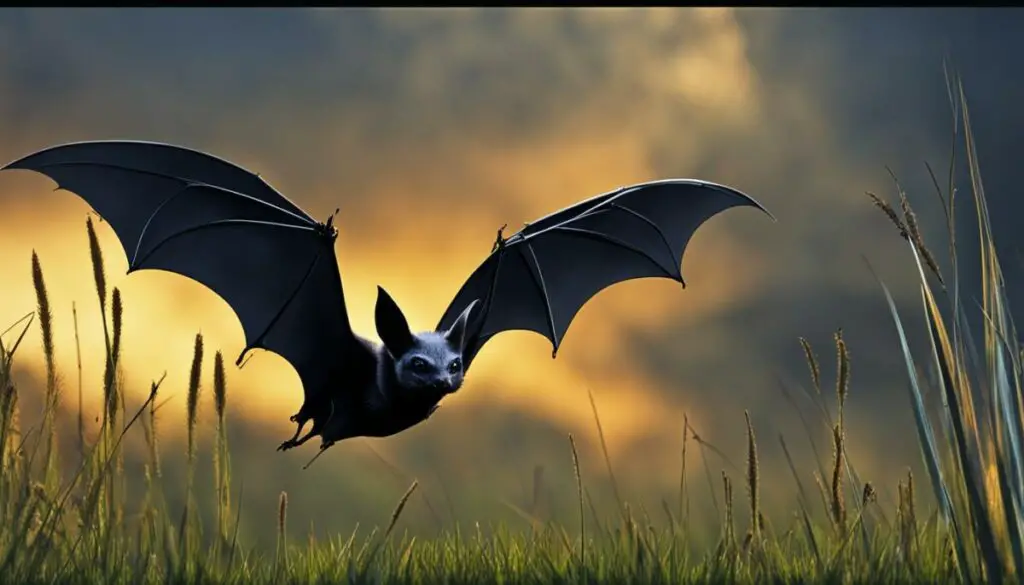Last Updated on 6 months by Francis
Have you ever wondered if bats can see infrared light? It’s a fascinating question that has intrigued researchers and bat enthusiasts alike. Bats are known for their exceptional night vision, but can they see beyond the visible spectrum? Let’s delve into the world of bat vision and explore the truth behind their ability to perceive infrared light.
Contents
Key Takeaways:
- Bats cannot see infrared light as it has a longer wavelength than visible light.
- Infrared light does not attract or repel bats; they are not attracted to any particular type of light.
- Bats have specialized eyes adapted for low-light conditions and are less sensitive to bright lights.
- Bats prefer to live in dark areas and avoid light sources to protect their eyes and maintain their sensory capabilities.
- Wind turbines pose a significant threat to bat populations, and efforts are being made to mitigate bat fatalities at wind energy facilities.
How Do Bats See Infrared Light?

Bats have unique eyesight that allows them to see in low-light conditions and navigate in the dark. However, they do not have the ability to see infrared light. Infrared light has a longer wavelength than visible light, making it outside the range of the bat’s visual system. While bats may have other sensory receptors, such as thermal receptors, that allow them to detect heat and navigate using echolocation, their eyes are not equipped to perceive infrared light.
Bat eyes are specifically adapted to function well in dim lighting, making them less sensitive to bright lights. This adaptation allows bats to hunt for insects during the night when most of their prey is active. In bright light, their eyes can become irritated and uncomfortable, affecting their vision and making them more vulnerable to predators. Therefore, bats tend to avoid areas with bright lights and prefer to inhabit darker environments where their vision is most effective.
It is essential to understand that bats are not blind; they can see in daylight, but their visual acuity is impaired in bright light. Their preference for darkness is not due to a lack of visual capability, but rather a strategic adaptation to maximize their hunting efficiency and protect their eyes from potential harm.
Overall, the bat’s inability to see infrared light is due to the limitations of their visual system, which is primarily adapted for low-light conditions. While they may have other sensory mechanisms to navigate and perceive their environment, such as thermal receptors and echolocation, their eyes are not designed to process infrared light. This adaptation allows bats to thrive in dark environments and avoid the potential dangers associated with bright lights.
What Types of Lights Are Bats Attracted To?
Bats are not generally attracted to lights and prefer to avoid bright environments. They are nocturnal animals and have eyes that are well-adapted to low-light conditions. However, there are a few exceptions to this behavior.
Migratory bats have been found to be attracted to red lights. Collisions with red signals have been observed, possibly due to the bats mistaking them for flowers or other food sources. Additionally, bats are commonly found near ultraviolet (UV) light areas. This is because insects are attracted to UV light, and bats, being insectivorous, follow their prey to these areas.
To summarize, while bats are not generally attracted to lights, certain species may be drawn to red lights or areas with UV light due to their association with food sources. Nonetheless, bats prefer darkness and tend to avoid spaces filled with bright lights.
Bats’ Attraction to Lights – A Summary
- Bats are not attracted to lights and prefer dark environments.
- Migratory bats may be attracted to red lights, potentially mistaking them for food sources.
- Bats can be found near areas with ultraviolet (UV) light due to the presence of insects, their primary food source.
- Bats generally avoid spaces with bright lights.
| Type of Light | Bat Attraction |
|---|---|
| Bright Lights | No |
| Red Lights | Possibly attracted, may lead to collisions |
| Ultraviolet (UV) Light | Associated with insect presence, may attract bats |
“Bats are not attracted to lights in general, but certain species may be drawn to red lights or areas with ultraviolet (UV) light due to their association with food sources.”
Why Do Bats Avoid Light?

Bats have a strong aversion to light sources for several reasons. Firstly, their eyes are not well adapted to handle bright lights. Bright lights can cause irritation and discomfort to bats’ sensitive eyes, impairing their vision and making them more vulnerable to predators. Bats rely heavily on their vision to navigate and hunt effectively, so they prefer to avoid areas with bright lights.
Another reason bats avoid light is that it can disrupt their natural behavior and physiological processes. Light exposure can interfere with their sleep patterns, foraging behavior, and reproductive cycles. Bats are most active during the night when darkness provides them with optimal conditions for hunting and finding shelter. Excessive exposure to light can disrupt their natural circadian rhythm and have negative impacts on their overall well-being.
Additionally, bats avoid light sources to minimize competition and potential conflicts with other species. Many insects are attracted to light sources, such as streetlights and outdoor lamps. Bats, being insectivores, rely on these insects as a primary food source. By avoiding light, bats can reduce competition for prey and ensure a steady food supply.
Table: Reasons Bats Avoid Light
| Reasons | Explanation |
|---|---|
| Vision Impairment | Bright lights can cause irritation and discomfort to bats’ eyes, impairing their vision and making them more vulnerable to predators. |
| Disruption of Natural Behavior | Excessive exposure to light can disrupt bats’ sleep patterns, foraging behavior, and reproductive cycles. |
| Minimizing Competition | Many insects are attracted to light sources, and bats avoid light to reduce competition for prey and ensure a steady food supply. |
Bats’ aversion to light is an essential adaptation that allows them to thrive in their natural habitats. By avoiding bright lights, bats can protect their sensitive eyes, maintain their natural behavior patterns, and secure a reliable food source. Understanding the reasons behind bats’ avoidance of light is crucial for their conservation and the preservation of their ecosystems.
Can Bats See in the Daylight?

Bats have the ability to see in daylight, but their vision is not as well adapted to bright light as it is to darkness. Their eyes are designed to excel in low-light conditions, making them more active and efficient during the night. While bats can perceive objects and movement in daylight, they prefer to stay in darker areas where their vision is most effective. The sensitivity of their eyes to bright light causes them to avoid it and seek out darker spaces.
Despite their preference for darkness, bats are not blind to light. They have functional daytime vision, which allows them to navigate and locate food sources. However, their visual acuity is diminished in bright light, making it more challenging for them to spot prey or objects with clarity. The structure of their eyes, which is optimized for low-light conditions, limits their ability to perceive details and colors in well-lit environments.
It is important to note that while bats can see in daylight to some extent, their behavior and activity patterns are primarily adapted for the night. Their unique vision and echo-location abilities enable them to thrive in the darkness, where they can efficiently hunt for insects and navigate their surroundings. The darkness provides them with the advantage of stealth and reduces the risk of predation.
Table: Comparing Bat Vision in Light and Darkness
| Bright Light | Darkness | |
|---|---|---|
| Visual Acuity | Diminished | Enhanced |
| Color Perception | Limited | Less Constrained |
| Movement Detection | Challenging | Sharp and Accurate |
In summary, bats have the ability to see in daylight, but their vision is better suited for low-light conditions. Bright light diminishes their visual acuity and limits their color perception. While bats can navigate and locate prey in daylight, they prefer to stay in darker areas where their vision is most effective. The darkness provides them with a competitive edge in hunting and reduces their vulnerability to predators.
What Are Bats Attracted To?

Bats are fascinating creatures with unique instincts and preferences. Understanding what attracts bats can help us better coexist with them and protect their habitats. Let’s explore some of the things that bats are naturally drawn to:
1. Fruits
Bats are major consumers of fruits, making them important pollinators and seed dispersers for many plants. They are attracted to the scent and sweetness of ripe fruits, such as bananas, mangoes, and figs. Bats play a crucial role in maintaining the ecological balance of fruit ecosystems.
2. Sealed Spaces
Bats are known to seek out sealed spaces as roosting sites. Caves, crevices, and the hollows of trees provide them with shelter, safety, and protection from predators. These enclosed spaces also offer stable temperatures, which are essential for their survival.
3. Waterbodies
Bats are attracted to waterbodies, such as lakes, ponds, and rivers, primarily due to the abundance of insects and other aquatic prey found in these environments. They rely on these water sources for hydration and as hunting grounds for their sustenance.
Bats’ attraction to fruits, sealed spaces, and waterbodies is deeply rooted in their evolutionary biology and ecological niche. By preserving and creating habitats that cater to these preferences, we can support bat populations and contribute to a healthier ecosystem.
How Do Bats React to Light?

Bats have a unique eye structure that makes them sensitive to light, especially bright lights. When exposed to intense light sources, bats can experience eye irritation and discomfort, which can disrupt their normal behavior. Their reaction to light includes flight behavior, as bats tend to fly away from bright areas and seek out darker environments where they feel more comfortable and secure.
In addition to physical reactions, bats also exhibit behavioral changes in response to light. They may alter their foraging patterns and hunting strategies to avoid well-lit areas. This behavior is largely driven by their natural inclination to avoid potential threats and maintain their sensory capabilities in dark environments.
“Bats have a unique eye structure that makes them sensitive to light, especially bright lights.”
Due to their sensitivity to light, bats tend to avoid areas with bright lights, whether they are natural or artificial sources. This behavior helps them navigate their surroundings more effectively and reduces the risk of predation. Therefore, it is essential to minimize light pollution and create darker spaces to support the natural behavior and well-being of bat populations.
| Light Source | Bats’ Reaction |
|---|---|
| Natural sunlight | Bats may seek sheltered areas during the day to avoid direct exposure to bright sunlight. |
| Artificial lights | Bats tend to avoid areas with bright artificial lights and may alter their foraging patterns to minimize light exposure. |
| Red lights | Migratory bats have been observed to be attracted to red lights, resulting in collisions and potential harm. |
| Ultraviolet (UV) lights | Some bats are attracted to UV lights because they are associated with high insect activity, a source of food for bats. |
Understanding how bats react to light is crucial for creating conservation strategies that protect their natural habitats and minimize human-induced disruptions. By adopting lighting practices that reduce light pollution and preserving dark areas, we can help maintain the balance of ecosystems and ensure the well-being of bat populations.
Impacts of Wind Turbines on Bats

Wind turbines have become an increasingly popular source of renewable energy, but their presence has raised concerns about the impact on bat populations. Research has shown that wind turbines pose a significant threat to bats, leading to high mortality rates.
Collisions with the rotating blades of wind turbines can disorient bats and cause fatal injuries. Additionally, the pressure changes near the turbines can further impair their ability to navigate effectively. This has led to the decline of certain bat species in areas with high wind turbine density.
To mitigate the ecological impacts of wind energy on bats, further research is needed to understand their migration patterns and habitat use. Conservation efforts can then be focused on identifying and protecting important bat habitats from wind turbine development. In addition, implementing measures such as altering turbine speeds, using ultrasonic acoustic deterrents, and exploring smart curtailment approaches can help to minimize bat fatalities at wind energy facilities.
Table: Comparison of Bat Fatalities at Wind Energy Facilities
| Wind Turbine A | Wind Turbine B | Wind Turbine C | |
|---|---|---|---|
| Species | Brown Bat | Hoary Bat | Red Bat |
| Number of Fatalities | 20 | 15 | 7 |
| Collision Rate per 1000 Hours | 5.2 | 3.8 | 1.9 |
Table: Comparison of Bat Fatalities at Wind Energy Facilities
This table provides a comparison of bat fatalities at different wind energy facilities. It highlights the number of fatalities and collision rates per 1000 hours for three bat species: Brown Bat, Hoary Bat, and Red Bat. The data shows that Wind Turbine A has the highest number of fatalities and collision rate, indicating a higher risk to bat populations.
Efforts to reduce bat fatalities at wind energy facilities are crucial for the long-term conservation of bat species. By implementing strategies that consider bat behavior and habitat use, we can strike a balance between meeting our energy needs and protecting these important pollinators and insect controllers.
Reducing Bat Fatalities at Wind Energy Facilities
Minimizing bat mortality at wind turbines is a critical goal for the wind energy industry. Various strategies and technologies are currently being explored to mitigate the negative impacts on bat populations. These initiatives aim to protect bats while still harnessing the benefits of clean and renewable wind energy.
Altering Turbine Speeds
One approach to reducing bat fatalities at wind energy facilities is to adjust the speed of the turbine blades. By slowing down or stopping the rotation of the blades during specific periods, such as peak migration seasons, the risk of bat collisions can be minimized. This strategy takes into account the patterns of bat activity and helps create a safer environment for these nocturnal creatures.
Implementing Curtailment Algorithms
Curtailment algorithms, which use real-time data to predict and manage bat activity around wind turbines, are another promising solution. These algorithms can analyze bat movement patterns and adjust turbine operation accordingly. By identifying high-risk periods and implementing temporary shutdowns, curtailing turbine operation during times of increased bat activity can significantly reduce collisions and fatalities.
Utrasonic Acoustic Deterrents
Ultrasonic acoustic deterrents are being explored as a potential tool to deter bats from wind turbine areas. These devices emit ultrasonic sounds that are unpleasant to bats, causing them to change their flight trajectory and avoid the area near the turbines. By creating a sonic barrier, ultrasonic deterrents can help steer bats away from potential collision zones, thus decreasing the risk of fatalities.
| Method | Effectiveness | Advantages |
|---|---|---|
| Altering Turbine Speeds | Medium | – Relatively low-cost solution – Can be easily implemented |
| Implementing Curtailment Algorithms | High | – Utilizes real-time data for accurate predictions – Customizable to specific wind turbine locations |
| Ultrasonic Acoustic Deterrents | Promising, but further research needed | – Non-invasive method – Potential to deter bats from turbine areas |
It’s important to note that these methods are still being researched and refined to ensure their effectiveness and minimize any unintended consequences. Collaborative efforts between wind energy developers, environmental organizations, and researchers are crucial to finding the best solutions that strike a balance between sustainable energy production and bat conservation.
Conclusion
In conclusion, bats do not possess the ability to see infrared light. Their visual system is not sensitive to the longer wavelengths associated with infrared light, and their eyes are better adapted for low-light conditions. Bats naturally avoid both natural and artificial light sources, as bright lights can cause discomfort and impair their vision.
Furthermore, bats are not attracted to any specific type of light. While migratory bats have been observed to be attracted to red lights, this is an exception rather than a general rule. Bats are more commonly found near ultraviolet (UV) light areas due to the presence of insects that are drawn to UV light. However, bats overall do not have a strong attraction to different types of lights.
It is important to note that wind energy development poses a significant threat to bat populations, as they are prone to collisions with wind turbines. Efforts are being made to minimize bat fatalities at wind energy facilities, such as altering turbine speeds and implementing acoustic deterrents. However, further research is needed to fully understand the ecological impacts of wind turbines on bats and develop effective strategies for their conservation.
FAQ
Can bats see infrared light?
No, bats cannot see infrared light. Their visual system is not sensitive to longer wavelengths, including infrared light.
How do bats see infrared light?
Bats do not have the ability to see infrared light. Their eyes are adapted for low-light conditions and are less sensitive to bright lights.
What types of lights are bats attracted to?
Bats are not attracted to any specific types of lights. They generally prefer to avoid spaces with bright lights, whether natural or artificial.
Why do bats avoid light?
Bats avoid light because their eyes are not well adapted to handle bright light. It can cause irritation, discomfort, and impair their vision.
Can bats see in the daylight?
While bats can see in daylight, they have better visual acuity in darker environments. They prefer to stay in dark spaces where their vision is most effective.
What are bats attracted to?
Bats are primarily attracted to fruits, as they make up a significant part of their diet. They are also attracted to sealed spaces with limited light sources, such as caves or crevices, as well as waterbodies that provide access to food resources like insects.
How do bats react to light?
Bats tend to avoid areas with bright lights. Exposure to bright lights can cause eye irritation, discomfort, and make them vulnerable to predation.
What are the impacts of wind turbines on bats?
Wind turbines pose a significant threat to bat populations. They can cause collisions and fatalities, disrupt migration patterns, and impact habitat use.
How can bat fatalities be reduced at wind energy facilities?
Measures being explored to reduce bat fatalities include altering turbine speeds, implementing curtailment algorithms, using ultrasonic acoustic deterrents, and considering smart curtailment approaches and textured coatings on wind turbine structures.
Conclusion
Bats cannot see infrared light and are not attracted to any type of light. They avoid light sources to protect their eyes and maintain their sensory capabilities. Wind energy development poses a significant threat to bat populations, and efforts are being made to mitigate bat fatalities at wind turbines. Further research is needed to better understand the ecological impacts of wind turbines on bats and develop effective conservation strategies.









